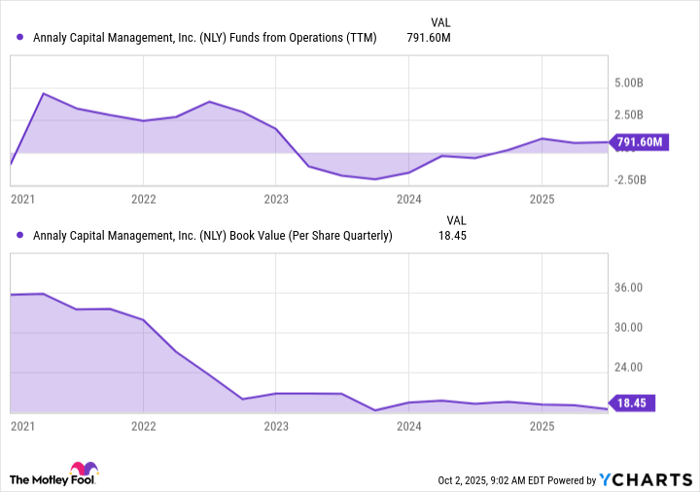Table of Contents
Key Points
-
Annaly Capital offers a high dividend yield of 13.3%, while Realty Income provides a lower yield of 5.3% and a history of consistent increases.
-
Annaly Capital invests in mortgage-backed securities and uses leverage to boost returns.
-
Realty Income invests in commercial properties and earns rental income from tenants that support its growing dividend payout.
- 10 stocks we like better than Annaly Capital Management ›
Dividend stocks can be an excellent source of passive income and also stability for investors. However, not all dividend stocks are created equally. Some companies have modest payout ratios that they look to grow steadily over time. Others may focus on delivering a high dividend yield that could be in the double digits, but it may be less reliable over time.
Two companies that offer appealing dividend yields are Annaly Capital (NYSE: NLY) and Realty Income (NYSE: O). Annally boasts a high yield of 13.3%, which could be more volatile over time. Meanwhile, Realty Income’s yield is 5.7%, but it has a history of consistently raising its dividend payout. If you’re weighing which stock is a better buy today, consider the following.
Where to invest $1,000 right now? Our analyst team just revealed what they believe are the 10 best stocks to buy right now. Continue »

Image source: Getty Images.
Real estate investment trusts are good for dividends
Annaly Capital and Realty Income are both real estate investment trusts (REITs). As REITs, these companies trade like stocks, but tax rules require them to distribute at least 90% of taxable income to shareholders as dividends.
This REIT structure makes them attractive for dividend investors seeking steady cash flow. REITs offer exposure to real estate without direct ownership, and their yields often exceed those of traditional equities. These stocks can be suitable for investors seeking steady income, as they distribute payments quarterly and sometimes even monthly, which Realty Income does.
The two REITs focus on different aspects of real estate
While Annaly and Realty Income are REITs, they operate in very different segments of the real estate sector.
Drilling down further, Annaly is known as a mortgage real estate investment trust (mREIT). As an mREIT, Annaly invests in mortgage-backed securities (MBS) rather than physical properties. The company earns income by buying or originating MBS, and profits from the interest spread between its borrowing costs and lending yields. To juice returns and support its double-digit dividend, Annaly utilizes leverage to achieve higher returns.
Realty Income, on the other hand, owns and invests in commercial properties, mainly single-tenant buildings leased under long-term net lease agreements. Its portfolio spans the retail, industrial, and office sectors, and tenants include recognized names such as Walgreens, 7-Eleven, Dollar General, and FedEx. Realty Income’s earnings are primarily tied to its rental income. This is how the company supports its dividend payment, which it has raised every year for an impressive 31 years.
Annaly and Realty Income come with different types of risk
One thing to bear in mind when investing in these stocks is the risk they present. Annaly utilizes leverage to enhance the returns on its MBS portfolio. This leverage helps the company to generate the income needed to support its ultra-high dividend yield. However, it also exposes investors to interest rate risk that may not be immediately apparent.
Annaly's performance is sensitive to Federal Reserve policy, interest rate fluctuations, and the shape of the yield curve. When short-term rates rise faster than long-term yields, Annaly’s net interest margin compresses, which in turn puts pressure on its earnings. Rising interest rates can also impact the value of its investments, creating a drag on its balance sheet and driving down the book value of the stock.

NLY Funds from Operations (TTM) data by YCharts
Conversely, in easing cycles or stable rate environments, Annaly can benefit from wider spreads as short-term rates fall faster than long-term ones. The company actively manages its portfolio using hedging strategies to mitigate some of this, but its reliance on repurchase agreements (which are short-term in nature) for funding introduces this risk.
Realty Income faces some risks as well. While it is also vulnerable to fluctuations in interest rates, its risk lies more in its tenants. Tenant defaults are a primary concern, especially during economic downturns or sector-specific disruptions.
Although it boasts investment-grade tenants, it wouldn't be immune from a wave of bankruptcies or lease renegotiations. Realty Income aims to mitigate some of these risks through geographic and sector diversification, as well as a more conservative use of leverage.
Which one is a better buy?
Annaly's dividend payout can be very appealing to income-driven investors. However, its payout could fluctuate more over time and is affected by the Federal Reserve — more specifically, short- and long-term interest rates — and overall housing market conditions.
Meanwhile, Realty Income offers a blend of income stability and long-term growth. Still, you'll want to monitor interest rate trends, as well as tenant health and the health of the overall economy.
I believe Annaly is well-positioned in the next year or two, especially if the Federal Reserve continues to reduce its benchmark interest rate, as such a move could be a tailwind for it. That said, Realty Income has a longer track record of raising its dividend payout, and I prefer it as a stock to hold on to for the long haul.
Should you invest $1,000 in Annaly Capital Management right now?
Before you buy stock in Annaly Capital Management, consider this:
The Motley Fool Stock Advisor analyst team just identified what they believe are the 10 best stocks for investors to buy now… and Annaly Capital Management wasn’t one of them. The 10 stocks that made the cut could produce monster returns in the coming years.
Consider when Netflix made this list on December 17, 2004… if you invested $1,000 at the time of our recommendation, you’d have $621,976!* Or when Nvidia made this list on April 15, 2005… if you invested $1,000 at the time of our recommendation, you’d have $1,150,085!*
Now, it’s worth noting Stock Advisor’s total average return is 1,058% — a market-crushing outperformance compared to 191% for the S&P 500. Don’t miss out on the latest top 10 list, available when you join Stock Advisor.
See the 10 stocks »
*Stock Advisor returns as of September 29, 2025
Courtney Carlsen has no position in any of the stocks mentioned. The Motley Fool has positions in and recommends Realty Income. The Motley Fool recommends FedEx. The Motley Fool has a disclosure policy.


